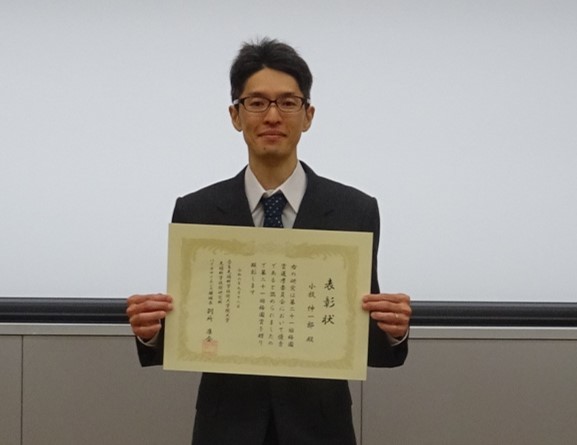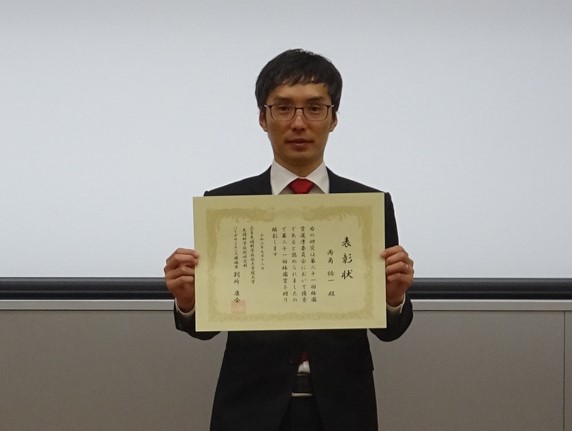Events & News
The 21th Umesono Prize Ceremony was held
Assistant Professor Shinichiro Komaki (Laboratory of Plant Secondary Metabolism) and Yuichi Morozumi (Laboratory of Microbial Interaction) received the 21th Umesono Prize. The 21th Umesono Prize Ceremony was held on September 18th at the Rethink Biological Science Seminar hall (L11), and many faculty and students participated and honored the Umezono prize winners.
The Umesono Prize has been awarded annually since 2004 to young researchers in Graduate School (Division) of Biological Sciences at NAIST who significantly contributed to biological sciences during his/her years at the institute. The prize is awarded to young researchers with a bright future to follow in the footprints of Dr. Umesono who enriched us with his personal and intellectual generosity. His spirit continues to inspire us and light our way. The award is mainly based on the originality and academic value of a paper which the awardee wrote as a first author.

Research Title
Acquisition of the kinetochore localization mechanism of the Chromosomal Passenger Complex by convergent evolution
Abstract:
The Chromosomal Passenger Complex (CPC) is essential for chromosome segregation during cell division, comprising key proteins like Aurora kinase, inner centromere protein (INCENP), Borealin, and Survivin. Correct CPC localization to the kinetochore is vital for its role in chromosome alignment and segregation regulation. While most CPC components are conserved across eukaryotes, orthologs of the chromatin reader Survivin have been only found in animals and fungi. This raises the question of how its essential role is fulfilled in other eukaryotes. By characterizing proteins that bind to the Arabidopsis Borealin ortholog, we identified BOREALIN RELATED INTERACTOR 1 and 2 (BORI1 and BORI2) as redundant Survivin-like proteins within the context of the CPC in plants. Similar to Survivin, BORIs bind to phosphorylated histone H3, crucial for CPC-chromatin association. However, this interaction is mediated by an FHA domain, a widely conserved phosphate-binding module, instead of a BIR domain found in other Survivin orthologs. We found that the defining feature of Survivin-type proteins is a helix that facilitates complex formation with other scaffold components, while the phosphate-binding domain, necessary for concentration at the inner centromere, evolved independently in different eukaryotic groups. Using sensitive similarity searches, we found conservation of this helical domain between animals and plants and identified the missing CPC component in most eukaryotic supergroups. Interestingly, we also detected Survivin orthologs without a defined phosphate-binding domain, which likely reflects the situation in the last eukaryotic common ancestor.

Assistant Professor Yuichi Morozumi
Research Title
Genetic mechanisms restrict fission yeast growth at high temperatures
Abstract:
Cells cease to grow above their permissive temperatures, a phenomenon generally due to protein denaturing and/or heat damage to other cellular components. The fission yeast Schizosaccharomyces pombe, which have been utilized as a useful model organism to explore diverse eukaryotic cellular processes, grows optimally around 30˚C and fails to proliferate at 38˚C and above. Here, we discovered that, in the presence of rapamycin, a specific inhibitor of the TOR Complex 1 (TORC1), fission yeast cells remain viable and proliferate at high temperatures that normally arrest their growth. In addition, mutations to the TORC1 subunit Mip1 and the TORC1 substrate Sck1 significantly improve high-temperature growth in the absence of rapamycin. These results indicate that TORC1, which is well-known as a growth promoting factor, negatively regulates fission yeast growth at high temperatures. For more comprehensive understanding of the regulatory elements that restrict high-temperature growth, we performed genome-wide screens and identified several additional factors that suppress cell proliferation at high temperatures. These findings strongly suggest that the high-temperature growth of fission yeast is impeded by mechanisms even below the temperatures deleterious to cell physiology. Thus, growth arrest at high temperatures may not necessarily be a direct consequence of heat damage to cellular components essential for cell growth.
(September 19, 2024)
